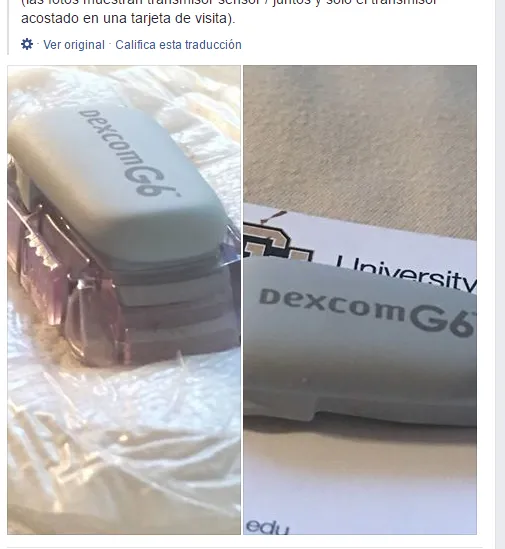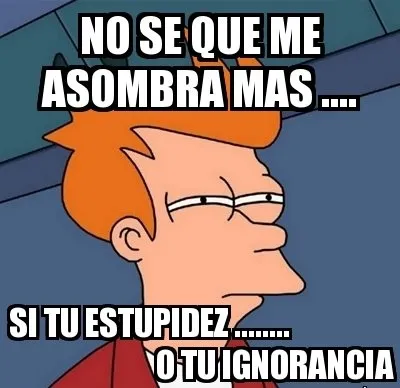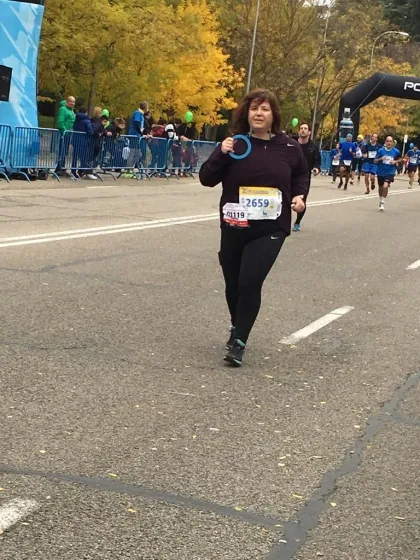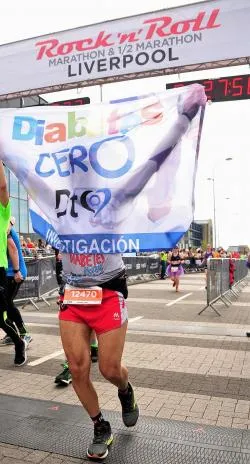To facilitate reading, I reproduce here the Jedi review, they are really extensive reflections ... I wouldn't give me time to write so much !!!: D: D: D: D: D
review dexcom g6com g6
When one puts the title Dexcom in an entrance, he has a great feeling of Deja-Vu.Because we talk about a continuous measurement system that is not new.That has been in the market for years.And above all, that does not stop being improved and updated.If we ask anyone with a little knowledgeable diabetes of diabetes technology which is the hardware that most evolves, it would most likely quote the North American company as a paradigm of speed in applying improvements.In 1999 Dexcom was created and in 2006 version 1 of this system was launched.It seems that many years have passed, but we talk about just over ten, in which Dexcom has implemented important improvements in the system, both in benefits and in technique and accuracy.Today, with the new version that has just launched and we already have in Spain, Dexcom G6 again shows that its evolution is continuous and that it can still be further.I have spoken on occasion that the brilliant speed of evolutions in this brand is sometimes disconcerting (and even frustrating when you want to buy a system that will be obsolete in a year), but in the background it is an indicative that we have a company that a company that a company thatconstantly improves and does not conform to what he has.I like that personally, although I understand the possible anger of a person spent the pasta in a system and who the following year launches another upper version.It was just a year ago when I made my Dexcom G5 review.
differences between Dexcom G5 and G6.
The new sensor-transmitter set of the Dexcom G6 is finer, less protuberant and is infinitely better designed, although its length is a bit higher.
But leaving aside the hypervelocity of Dexcom evolving his MCG sensor -only comparable to that of the millenary hawk -we reach the current point where he said above, we have already available the new Dexcom G6.I have been able to enjoy this system for a month thanks to the team that yielded Iberian Novalab -su official distributor in Spain- (external link) so that I can test it first hand and give my impressions that I tell you below.Of course, and as always, I have no economic link when trying it or any commitment, something that always makes it clear in the section of "Conflict of Interest" within the editorial policy of the blog and that I advise you to read.
review of the continuous glucose meter dexcom g6
As you know, since June I have put the implantable sensor Eversese XL of Senseonics/Roche and which I already talked about after spending my Ecuador of the 180 days that its useful life lasts, and therefore my tests with the G6 were going to be continuously compared from theMinute one with the Roche sensor.And this is logically very good, because carrying two systems simultaneously allows both.In case of doubt or differences, a capillary can tell you which of the two deviates.But if both go the same, the consequence is clear: both go well.And the result was ... that both have gone the same.Nailed.Like two drops of water.As a Swiss glucose measurement clock.Really curious.Therefore, the Dexcom G6 has behaved at all times with very, very exact figures.
comparative dexcom g6 vs Eversese xl
The Dexcom G6 has been even at all times with the Eversese XL, thus demonstrating that both have a great exactis.
You are good, Flanagan, this is what I thought of G6 a few days after putting on the first sensor.As I said above,Tasting this system was very easy for another to carry another arm and from which he had already proven his great accuracy.But the Dexcom G6 has proven to be as accurate as Eversese XL.Both are really impressive in their accuracy.Forgetting the implantable that I already talked about in his day and notMard accuracy (9%) that its predecessor version (the G5), has shown (at least in my case, although I know that I am not the only one who says this) to be less reliable and accurate than this.The G5 did not convince me.However, the Dexcom G6 is impressive from minute one.
What has changed to be so good?
In the last EASD Congress I was talking to people from Dexcom and Novalab and they told me that the improvements are sometimes subtle, but added make everything better.In the case of G6, we talk about a system that has systematized and uniformized each and every one of the inserts with a new and wonderful applicator, which has surpassed that of free (until then winner) at many points.Incredible the softness with which the sensor inserts.And let's not forget that Dexcom's filament is longer than competition because it enters oblique.Nothing is noticeable.I would prick twenty times with this system.A large and colorful applicator, which curiously must be thrown once the sensor is placed.Therefore, new sensors are bulky, because they include this applicator;Perhaps the only silly paste (for saying some) that derives from this new insertion system that the Dexcom meter shouted for a long time.Let us therefore forget that infamous applicator that was afraid.You can click without fear of a child because it does not hurt.Do not know.And now having a system to place the sensor again and again in the same place and with the same effectiveness has contributed to improving its accuracy a little more.If we add to that his programming (algorithms) or in some small change in the chemistry of the membranes of the filament ... The result is that even having the same Mard as the G5, the Dexcom G6 is best noticeable from the first day.Again and again it gives you the exact values.
my experience with the mcg
Benefits
A sensor that now lasts ten days ... the already mentioned applicator ... all the usual alarms fully configurable plus a new hypoglycemia forecast (an imminent urgent level alert ") ... different customizable alerts for the day or night ... indication forPediatrics from just two years ... without interference in the results by Paracetamol/acetaminophen ... a new receiver ... up to five caregivers who can telemonitory in real time the person who carries the system ... and no need for calibration.Your star benefit.Just because.We have already reached the point where continuous glucose meters do not require calibration.At least this.Technology is so accurate that we have surpassed capillary meters.Although other systems still calibrate, over the next few months we will see new candidates that add to the absence of calibration, since as I have said it is losing the sense to calibrate a system with another that is worse than the first.In the case of Dexcom G6, each sensor comes with a code that we must introduce when starting its useful life.And that will already give us the ten days without calibrations.However, we can always calibrate manually if necessary or use the sensor in “old mode with calibrations” if we do not introduce the code when starting with that sensor.
dexcom g6 placed
The setTransmitter-Sensor now bothers much less, it is more comfortable to carry and its fabric patch is completely adhered to the entire transmitter socket.
The new #dexcomg6 does not need calibration
And in terms of information management, the G6 can be communicated with the receiver (without the need for mobile) or with the smartphone (we can acquire it in both configurations).On the mobile, it is enough to install the Dexcom G6 app, which is available both in iOS and Android.Although it must be said that in Android it is very sibarite to function and Dexcom only guarantees compatibility with star phones, such as Samsung Galaxy and few more.And if we want to analyze the data with Clarity (external link), we have an app, which this week has just launched translated into Spanish.In principle with this app compatibility on Android will be much greater than with the previous one.As I just left this week, I have not had too much time to try it.But what I have been able to tangle with it, what I see is that it is an extension of the desktop platform.The data and reports are not generated specifically for the smartphone, but are simply generated based on your filters and show them on the screen a large size, without being adapted to the phone screen.Therefore, you must move through the leaves of the graphics as if you were watching a Word document or a PDF made on a computer.In summary, the Clarity app convinces me by non -adaptability to the smartphone.But the reports they present are complete and are generated by accessing our clarity data in the cloud.
The new transmitter is a little longer, but much more comfortable to carry for its slightest thickness and be better integrated into the sensor base.
The new transmitter is a little longer, but much more comfortable to carry for its slightest thickness and be better integrated into the sensor base.
What has changed is the transmitter-sensor set.The transmitter is now more flat and less bump.The way to fit in the sensor socket is better, simpler and without pointed corners as before.And the Zocalo is also different.He is now attached throughout his surface against the adhesive cloth dressing, which gives you much more confidence.And when placing the transmitter, everything is very compact, without highlights and is safer against hooks.I have taken the three test sensors without putting any additional protection on top and have endured well with sport included.In summary, the sensor-transmitter pack is now more compact and comfortable.And the system to get the transmitter once the sensor is finished is also original and well resolved: you have to fold the socket and split it.Only then is the transmitter from where I was totally fitted.
To get the transmitter from a finished sensor, you have to break the socket.
dexcom and chewing sensors
As I said, the sensors last 10 days, three more than the previous ones.And the transmitter about three months.Yes I know.Now is when you tell me that the sensors stretch and that with a bit of the transmitter you can get hand to change the batteries.Well, I do not recommend one thing or the other.I know that when we pay the sensors, having 10 days is better than 5, 20 better than 10, and that the transmitter lasts as much as possible.But if we now have a system that does not require calibration and that we can finally keep the capillary meter at home, stretch it only supposes that we will have to continuously collapse the accuracy of the system from day 10, and therefore we will have a dexcom"Ancient" that requires comparing and most likely to calibrate.For me now no longer compensates to stretch a sensor.Not now.And if what you think is to keep stretching the sensor without clicking on your finger once, already directlyI advise you vividly.Remember that from day ten everything can fail, or little by little or suddenly.And we play a lot if we trust a system that does not give us the right results.As I said, now that we have a system in which we can trust and make decisions and does not require calibrating, for me stretch it no longer makes sense.Anyway, those of Dexcom have put the most difficult things than before and those who are stretching them get very few more useful days.Ah, and there is no retrocompatibility.G5 and G6 are incompatible in their sensors, receptors and transmitters.
my experience
I think it has become clear that the Dexcom G6 liked it a lot.I was surprised because by having the same Mard as the G5, I expected something similar.But not only is it condemned exact at all times, but you do not lose the values collected by the sensor, there are no connection losses even during the night when you are supported on the sensor's arm ... Therefore, everything works as it should.Only a couple of sensor errors, which have been resolved by themselves after a couple of minutes.
Dexcom sensor error screen G6
Just a couple of "sensor error" during the month of testing.And without signal losses.
On the other hand, I must admit that the trend arrow is one of the battle horses of MCG systems.In almost everyone I have tried, they fail many times in their predictions.And that endangers applying those settings in the guideline based on the trend arrow.Many times it marks a trend that changes completely in the following reading.Therefore, I would not recommend acting based only on trend arrows, but rather on the historical of previous measurements.I still do not see the trend systematically.But it is not Dexcom's problem, but of all.
trend arrow in the dexcom g6
The trend arrow changes from one reading to the next.Be careful to make decisions based only on it.
As for data management, I have mostly used an iPhone with the Dexcom G6 app, but I have also tried the new receiver.It is a content size, with a mobile appearance, although smaller.Color touch screen and with the same benefits we have in the app.In both cases more than correct.With very configurable alarms, both the app and the receiver give us the classic information of these systems.What we cannot do is analyze the data at the statistical level, since for that we need to access the Clarity platform, of which there is still no access via app and we need to do it through a browser.The Dexcom G6 has alarms that really honor its name;They are effective and alarman.A lot.As you ignore you end up calling the attention of all the people around you.Actually that is the function of an alarm.And then each person can configure it depending on their needs or even disable them.And the new alert called "low imminent level" warns us in advance of up to 20 minutes in foreseeable situations of important hypoglycemia (55 mg/dl is the fixed threshold).To me personally this alert seems to me that it is a good idea, although it does not work brilliantly, since to give it a good note it should be more forecast and notify more in advance.When I am already on the edge or in full hypo, I tell me that I will reach 55 mg/dl in a few minutes it seems an unnecessary and almost rude obviousness.I can't find great use in this function as it has worked for me.But if they improve it, it is a good idea.On the other hand, your alert systemCustomizable allows you to create a second set of notices, something that is very useful for example during the night, where our safety thresholds are usually different.A very useful function.
And I don't want to end up without citing a program that has improved a lot about previous versions.I refer to the Clarity Data Management Platform.Although in Spain we still cannot access via APP (shortly), if we do it from a computer we will have access to software that is in my opinion among the best in the balance between benefits and usability.And the latter is very important, because dealing with all this diabetes big-data is not something pleasant traditionally.But now there are programs that have achieved that balance that I mean between benefits (that is, information that provides us) and the always necessary usability and intuitivity in their interfaces.A platform of this type must be simple, but powerful.That you know how to handle it in a short time, but that offers you everything you need.And Clarity does it very well.For me of the best in that balance between what it offers and simplicity.I see it adequate for all users.But it offers everything we need and in a very simple and visually friendly way.It incorporates the always useful AGP graphic, in addition to of course edition of glycosilada, variability, etc.I am looking forward to seeing how all these graphics compact on the screen of a mobile when the app is available.
Conclusion
In summary, I believe that the Dexcom G6 is significantly better than everything the company has done so far.In all aspects.And as for accuracy, it is the best I have tried, at the same level as Eversese XL.Honestly, I must confess that I am dying to see this great sensor communicating with the Tandem insulin pump and executing the basal automation algorithms that are already ready by the manufacturers of the Great T. For what I could see in the pastEasd in Berlin (and that I liked it a lot), I think it will be a union that will put the things very difficult for Medtronic with his 670g.








